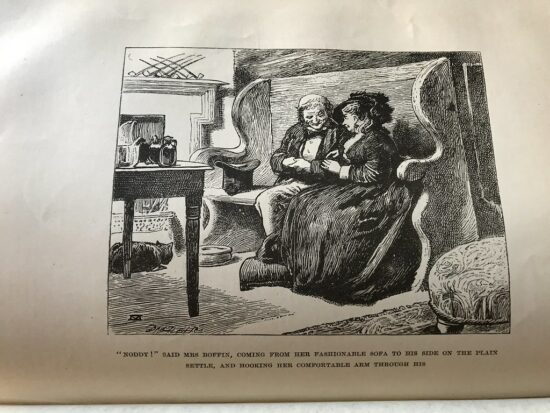Introduction
A classic book by Charles Dickens, Our Mutual Friend, explores themes of social injustice, greed, love, and redemption. Published in 1864–1865 as a serial, the novel follows the lives of various characters whose paths intertwine in a complex web of secrets, mistaken identities, and unexpected connections. With its intricate plot, vivid characters, and insightful commentary on Victorian society, Our Mutual Friend remains a timeless masterpiece of English literature.
Plot and Storyline
Our Mutual Friend begins with the mysterious death of John Harmon, a young man who was set to inherit a substantial fortune from his father. The story takes an unexpected turn when it is revealed that Harmon’s body has been misidentified, allowing him to assume a new identity and observe the true nature of those around him. Through this deception, Dickens explores the themes of identity, deception, and the corrupting influence of wealth.
As the plot unfolds, we encounter a wide array of characters, each with their own unique struggles and desires. Lizzie Hexam, a young woman who collects debris from the river, becomes entangled in a love triangle involving her suitor, Eugene Wrayburn, and a mysterious man named Bradley Headstone. The complex relationship between these characters highlights the themes of love, jealousy, and the consequences of personal choices.
Another key storyline revolves around Bella Wilfer, the young woman who was set to marry John Harmon before his alleged death. Bella’s transformation from a materialistic and ambitious young woman to a more compassionate and selfless individual serves as a central theme of the novel. Dickens explores the transformative power of love and the importance of recognizing one’s own prejudices and flaws.
Characters
Dickens populates Our Mutual Friend with a rich tapestry of characters, each representing a different aspect of Victorian society. John Harmon, under the guise of John Rokesmith, undergoes a profound transformation as he navigates the world of wealth and privilege. His growth as a character underscores the novel’s exploration of morality, responsibility, and the corrupting influence of money.
Lizzie Hexam, a strong-willed and independent young woman, serves as a symbol of resilience and virtue in the face of adversity. Her relationships with Eugene Wrayburn and Bradley Headstone highlight the complexities of love, loyalty, and the consequences of one’s actions.
Themes and Symbols
Our Mutual Friend addresses several major themes that resonate throughout the novel. One prominent theme is the stark divide between the rich and the poor, highlighting the social inequality and injustices prevalent in Victorian society. Dickens portrays the wealthy as morally bankrupt and the poor as victims of circumstance, shedding light on the need for compassion, understanding, and social reform.
The river Thames also emerges as a powerful symbol in the novel. It represents the ebb and flow of life, reflecting the characters’ journeys and the cyclical nature of human existence. Moreover, the river serves as a metaphor for the hidden depths and secrets that lie beneath the surface of society.
Writing Style
Dickens’ writing style in Our Mutual Friend is characterized by his vivid descriptions, rich characterizations, and keen observations of human nature. His use of humor, satire, and social commentary adds depth and complexity to the narrative. Dickens employs various literary techniques, such as foreshadowing, symbolism, and intricate plot twists, to engage the reader and create a sense of anticipation.
Setting and Atmosphere
The setting of Our Mutual Friend, the bustling city of London in the mid-19th century, plays a significant role in shaping the atmosphere of the novel. Dickens vividly captures the sights, sounds, and smells of the city, immersing the reader in its crowded streets, murky riverbanks, and stark class divisions. The atmospheric descriptions contribute to the overall tone, highlighting the stark contrast between the opulence of the upper classes and the squalor of the working poor.
Historical, Social, or Political Context
Our Mutual Friend reflects the historical, social, and political context of Victorian England. Dickens exposes the harsh realities of the industrial revolution, where rapid urbanization and economic disparities led to widespread poverty and social unrest. The novel explores the detrimental effects of unregulated capitalism and the need for social reform, echoing Dickens’ own concerns about the injustices of his time.
Impact and Reception
Upon its publication, Our Mutual Friend received critical acclaim and cemented Dickens’ reputation as one of the greatest novelists of his era. The novel’s intricate plot, memorable characters, and social commentary resonated with readers and critics alike. Its enduring popularity and ongoing influence on subsequent literature demonstrate the timeless relevance of its themes and the enduring power of Dickens’ storytelling.
What are some examples of the author’s use of humor and satire in the novel?
Charles Dickens was known for his skillful use of humor and satire, and Our Mutual Friend is no exception. Here are a few examples:
1. The character of Mr. Podsnap: Mr. Podsnap is a wealthy and self-satisfied man who embodies the shallow and narrow-minded attitudes of the upper class. Dickens employs satire to mock Podsnap’s extreme self-assurance and his belief in the superiority of his social circle. For instance, Podsnap’s name itself suggests a snap judgment based on appearances. Dickens uses humor to highlight the absurdity of Podsnap’s views and to critique the arrogance of the upper class.
2. The Veneerings’ dinner parties: The Veneerings are a nouveau riche couple who are eager to impress others with their wealth and social status. Dickens satirizes their extravagant and ostentatious dinner parties, which are filled with pretentious guests and excessive displays of opulence. Through witty dialogue and exaggerated descriptions, Dickens exposes the superficiality and hypocrisy of these social gatherings, poking fun at the absurd lengths to which people will go to maintain appearances.
3. The character of Silas Wegg: Silas Wegg is a one-legged man who poses as a literary genius and attempts to exploit the Boffins, a wealthy couple. Dickens employs humor in Wegg’s exaggerated claims of his intellectual prowess as well as in his comical attempts to manipulate and deceive others. Wegg’s character serves as a satirical representation of greed and deceit, revealing the absurdity of his schemes and the gullibility of those who fall for his tricks.
4. The Pawnbroker’s Shop: In one memorable scene, Dickens uses humor to satirize the pawnbroker’s shop, a symbol of poverty and desperation. He describes the bizarre assortment of items pawned by individuals in dire need, ranging from false teeth to artificial limbs. Dickens exposes the harsh realities of poverty and the dehumanizing effects of a society based on materialism through this humorous portrayal.
These examples demonstrate Dickens’ skill in using humor and satire to critique societal norms, expose hypocrisy, and highlight the follies and vices of his characters. His wit and humor add depth and entertainment value to the novel while also serving as a vehicle for social commentary.
Final Conclusions
Our Mutual Friend remains a literary masterpiece that continues to captivate readers with its compelling plot, vibrant characters, and incisive social commentary. Through its exploration of themes such as social inequality, love, and redemption, Dickens crafts a thought-provoking narrative that exposes the flaws and virtues of human nature. With its enduring relevance and lasting impact on literature and society, Our Mutual Friend stands as a testament to Charles Dickens’ brilliance as a storyteller and social commentator. Its exploration of complex characters, intricate plotlines, and timeless themes ensures its place as a beloved classic that continues to resonate with readers today.
Sources
Our Mutual Friend | Victorian, Satire, Social Criticism | Britannica
My favourite Dickens: Our Mutual Friend | Charles Dickens | The Guardian






